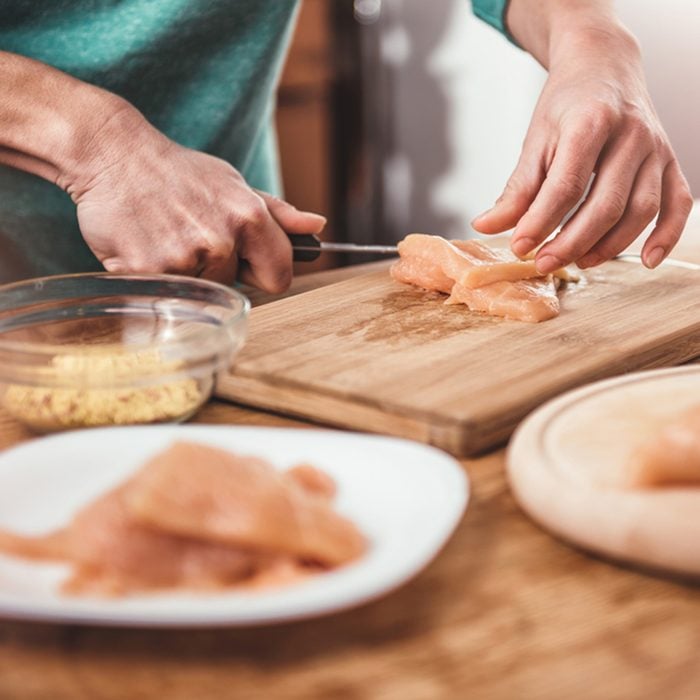
There’s a reason “tastes like chicken” is such a popular phrase. Most home cooks reach for boneless, skinless chicken breast for just about any meal. (We know because you’ve sent in thousands of chicken recipes!) Chicken is cheap, plentiful and pairs with nearly anything. But it’s important to remember to take heed when preparing this bird. Raw chicken can be harmful if it’s not handled with care. Cook your next chicken dinner safely by avoiding these common mistakes.
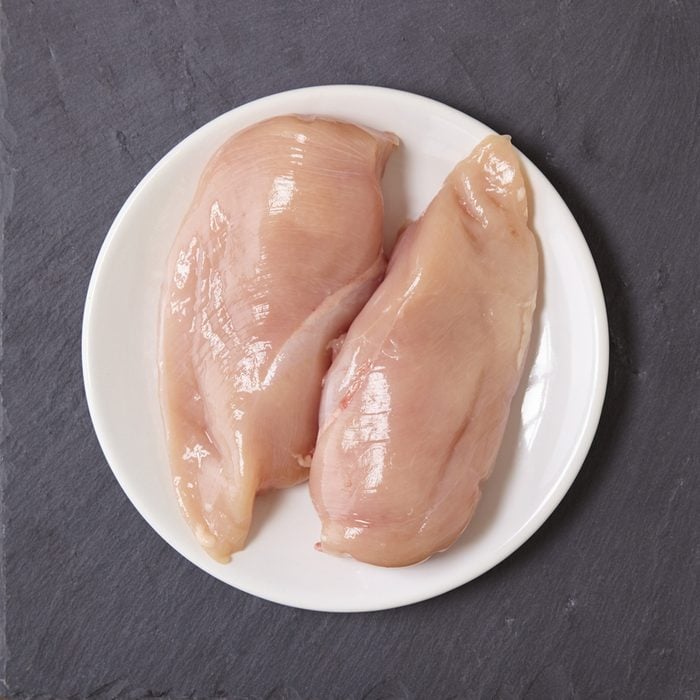
Leaving raw chicken out too long
Many cooks will put chicken out on the counter to thaw, then promptly forget about it. But it’s important to treat chicken as an item with a time stamp. At room temperature, meat can begin to develop harmful bacteria, which if consumed may result in various foodborne illnesses—aka food poisoning.
What to do instead:
Place chicken in the fridge immediately after you’ve finished shopping. Only take it out when you are prepared to cook. If the chicken is frozen, thaw it in the fridge up to two days before cooking. Read more about how to store raw chicken.
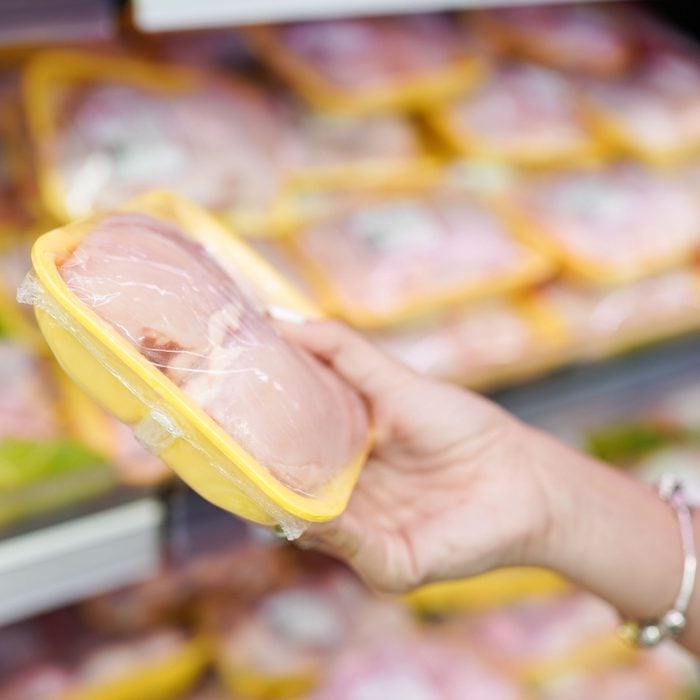
Not knowing when to toss raw chicken
Raw chicken is supposed to be pink and a little bit slippery—not slimy, smelly or turning gray. If it’s any of the above, it’s time to toss it. (Learn more about how to tell if chicken is bad.) Whether you brought it home from the grocery store recently or took it out of the freezer to thaw, raw chicken is really only supposed to sit in the refrigerator for one to two days before cooking.
What to do instead:
Shop intentionally, with a plan to cook chicken within two days if you don’t want to freeze it. Always check raw chicken for the correct color, texture and smell before you use it in a recipe.
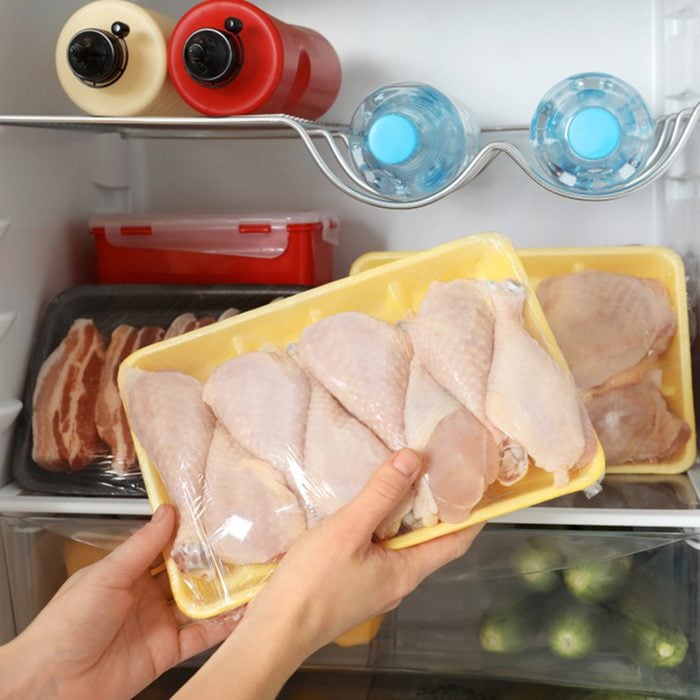
Storing raw chicken improperly
Think your meat can stay on any shelf in the fridge? Think again. Chicken juice has a tendency to leak and drip outside of its container. This can be bad news (contamination) if it comes into contact with your produce.
What to do instead:
Place chicken on a plate, then cover and store on the bottom shelf of your refrigerator. Then, when it’s fully thawed, learn how to cut a whole chicken.
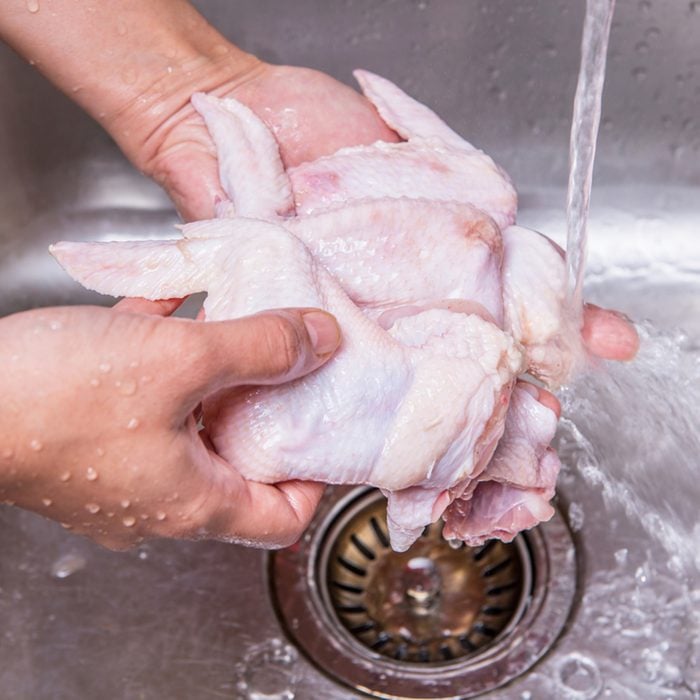
Rinsing chicken before you cook
Contrary to popular opinion, raw chicken doesn’t need to be (and shouldn’t be) rinsed in any way. Rinsing can cause bacteria on the chicken to splash and cling to surrounding surfaces, rather than eliminating them from the chicken. Find more food safety mistakes you might be making, and learn about more foods you should never wash before cooking.
What to do instead:
Skip washing the chicken, but make sure you pat-dry it first, like many professional chefs do. Then, send it straight to the frying pan….or oven…or slow cooker.
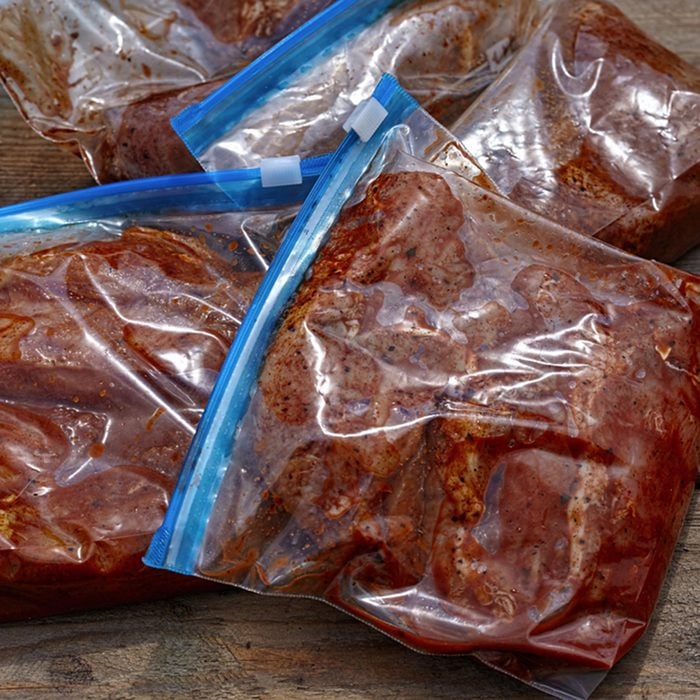
Marinating chicken improperly
Chicken tastes delicious with a zesty marinade. In fact, it’s one of the easiest ways to tenderize the meat. However, leaving raw chicken breasts or thighs on the counter to marinate can take your dinner from delicious to dangerous, as bacteria can grow better when it’s warm. And though it may seem thrifty, never reuse marinade after it’s come into contact with raw meat.
What to do instead:
Marinate your chicken in an airtight container in the refrigerator. Toss the juices when you’re done.
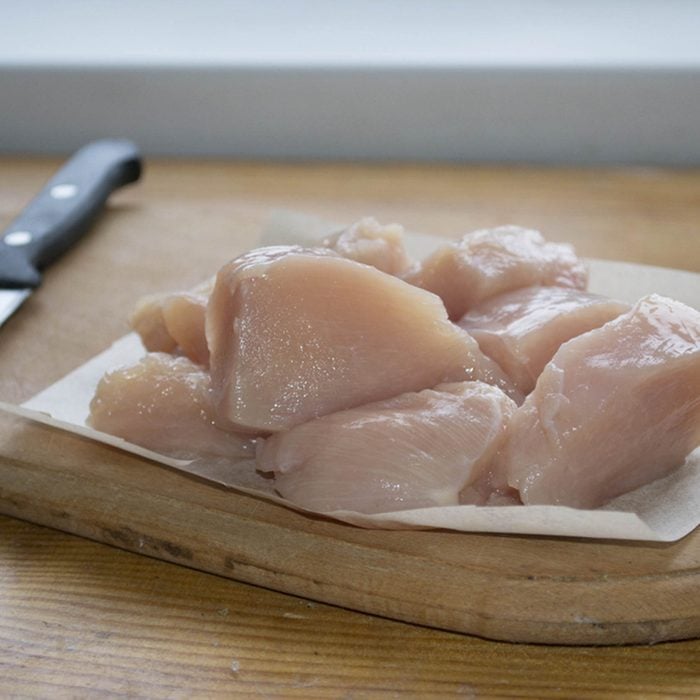
Reusing tools that have touched raw chicken
If you’re a savvy cook, you probably know a thing or two about multitasking. It’s a time-saver to bounce around the kitchen, stirring a skillet one moment and slicing vegetables the next. When it comes to handling chicken, however, cross-contamination can put you at risk for salmonella. Avoid using utensils, cookware, cutting boards and anything else after they’ve been exposed to raw chicken.
What to do instead:
Thoroughly wash items after they come into contact with the raw chicken.
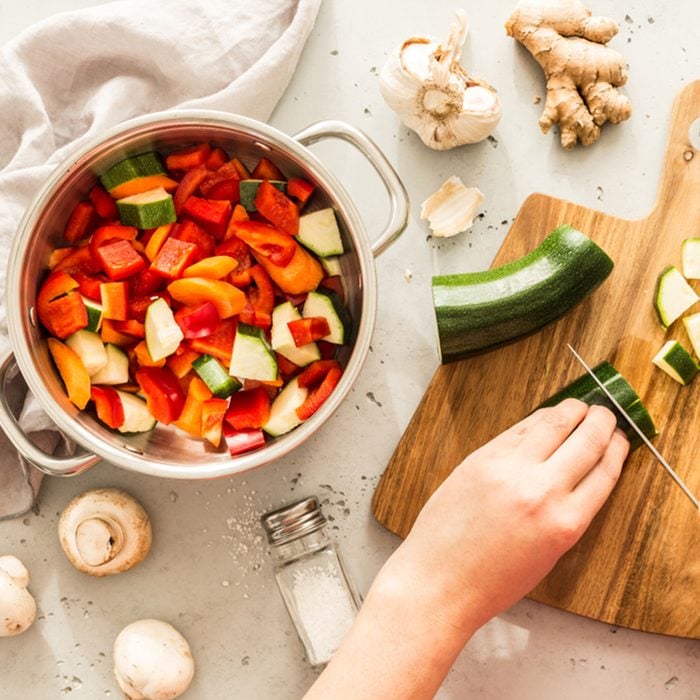
Letting raw chicken touch other foods
For those who work in tiny kitchens, the cutting board can be priceless space. It may seem easy to chop the romaine lettuce for your salad on the same surface where you’ve cut your raw chicken into slices. Unfortunately, this is an easy way for chicken juice to seep into, and yes, contaminate your food. That’s why you should have at least two cutting boards!
What to do instead:
Avoid placing raw chicken near ingredients that aren’t being cooked. Gain back some workspace with these genius kitchen organizing ideas.
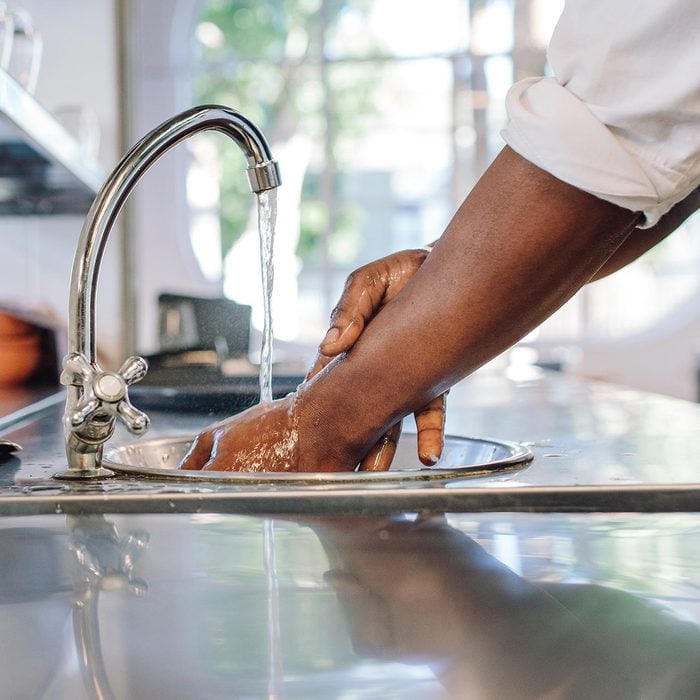
Forgetting to wash your hands
Your hands are often the best tool when it comes to breading and seasoning your protein. But be careful; once they come in contact with chicken juice, they can quickly cross-contaminate anything you touch. Drawer knobs, countertops, seasoning bottles and much more may be covered in harmful bacteria. Find out where germs are lurking in your home.
What to do instead:
Take extra care not to touch any surfaces after handling raw chicken. And if you do, be sure to wipe them down afterwards. A technique that can help is to practice handling chicken using only one hand. That way, the other hand is free to grab the saltshaker or turn on the water when needed. Finally, wash your hands with plenty of soap.
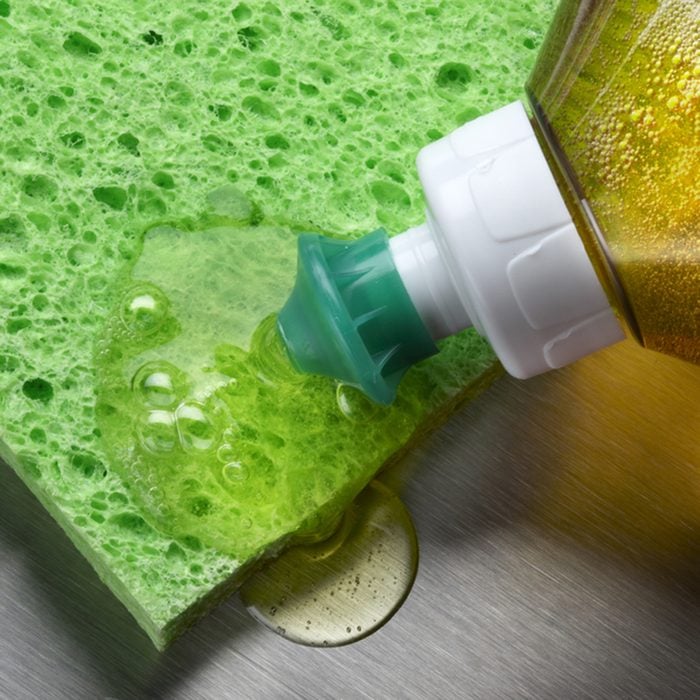
Keeping the same sponge in rotation for months
You might be careful to wash your tools after they come into contact with raw chicken—but have you thought about the sponge you use to clean those tools? Generally, we think of sponges, dishrags and other tools as clean items, but they’re home to dangerous pathogens and bacteria—especially if you’ve been using them to clean tools that touched raw chicken.
What to do instead:
Wash your dishtowels regularly and sanitize your sponges every other day. (One way is to put a wet sponge in the microwave on high for 2 minutes.) How often you replace your sponge depends on what you’re using it for. If it’s a sponge that cleaned up after poultry, sanitize once, then toss after another day or two.